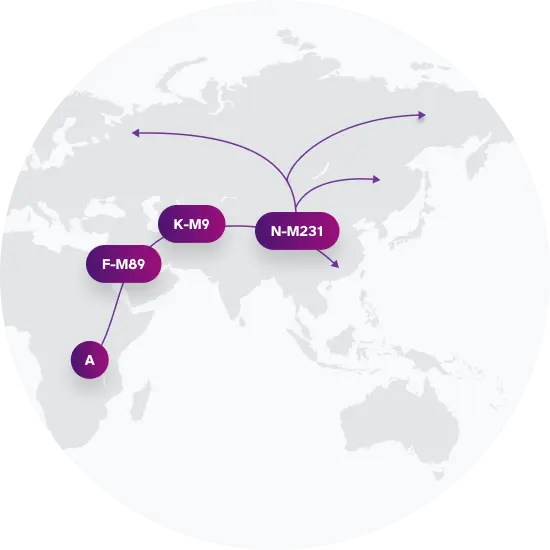Haplogroup N-CTS2929
What is Paternal Haplogroup N-CTS2929?
Haplogroup N-CTS2929, also known as Haplogroup N-M231 (Y Chromosome Consortium long-form label), is a genealogical group of lineages defined by unique genetic markers present on the Y-chromosome. Your paternal haplogroup, or that of your father if you do not have a Y-chromosome, paints a picture of your ancient origins and the migrations of your ancestors. Although your paternal haplogroup reflects just one of your many ancestral lineages, it carries information about that lineage over tens of thousands of years.
Haplogroup N-CTS2929 is descended from haplogroup N-M231. Among 23andMe research participants, haplogroup N-CTS2929 is commonly found among populations in the United Kingdom and Finland.
It's important to note that your haplogroup doesn't define your current ethnic identity; rather, it provides an insight into your deep ancestry on the paternal side.
 Paternal Haplogroup Origins N-M231
Paternal Haplogroup Origins N-M231Top Surnames with Haplogroup N-CTS2929
For surnames with sufficient representation in the data, these percentages represent the frequency with which each surname is found in individuals exhibiting this genetic marker.
Haplogroup N-CTS2929 is linked to men with indigenous Siberian ancestry
Haplogroup N-M178 is the most common paternal lineage in people of indigenous Siberian descent, but it probably only arrived in Siberia within the last 3,000 years. By the time members of N-M178 arrived in Siberia from Mongolia and northern China, other humans had probably been there for tens of thousands of years. In fact, research suggests that modern humans have been in Siberia near the Altai Mountains for 40,000 years, mostly as hunter-gatherers. The original inhabitants of Siberia probably migrated from Central Asia, not long after the original human exodus from Africa 50,000-70,000 years ago.

